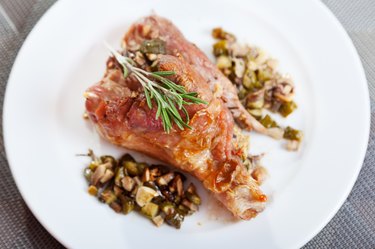
Freezing dressing at Thanksgiving saves time and energy, whether you're making stuffing the night before or preserving extra portions after a big event. After all, when you prepare your famous make ahead sausage stuffing before Thanksgiving Day, you'll gain time that you can spend with family and friends. On the other hand, if you don't want your special dressing to go to waste after the holiday, you'll have a freezer stocked with the makings of cornbread dressing fritters and other goodies. Freeze Thanksgiving dressing using one of a number of methods.
Freeze Uncooked Stuffing
Video of the Day
Partially making stuffing the night before Thanksgiving streamlines your busy holiday. You can freeze uncooked dressing after you've assembled it. One option is to place it in a shallow container so it freezes quickly. Alternatively, freeze the dressing before putting it together, using separate containers for dried bread cubes; cooked onion and celery; and cooked, chopped turkey giblets or cooked shellfish.
Video of the Day
Celery and onions taste stronger once they're frozen. Adjust seasonings accordingly to stand up to their more intense flavors, or cut back on the number of aromatic vegetables. It can take some experimentation to help determine which balance of flavors makes the best frozen dressing.
Freeze Cooked Stuffing
Whether you're making stuffing the night before the holiday or preserving leftovers, quality control is crucial. The best frozen dressing is one that avoids the pitfall of becoming soggy when reheated. To get just the right texture for your make ahead sausage stuffing or other favorite pre-cooked dressing, slightly under-cook stuffing that you plan to freeze by taking it out of the oven 10 minutes before it would normally be done to help it retain its quality.
Cool the dressing quickly to room temperature by placing the pan in another pan filled with cold water and ice cubes. Use a shallow pan for the stuffing if you have one, so it will freeze as quickly as possible. This precaution minimizes the growth of dangerous bacteria.
Freeze Dressing in Portions
Stuffing baked in muffin tins freezes and reheats quickly, which helps avoid problems with bacterial growth. It also helps if you're planning a recipe in which you need several individual batches of it, as with cornbread dressing fritters. You can also transfer leftover stuffing from one large container into tins for freezing dressing. Whether you're freezing fresh-baked dressing or leftovers, slip the muffins out of the tins once they're frozen, and store them in freezer bags. Reheat the number of muffins you want by microwaving them in 30-second intervals or baking in foil for 10 to 15 minutes at 350 degrees Fahrenheit.
Cook and Reheat Safely
Frozen dressing, whether cooked or uncooked, keeps in the freezer for two to six months. Reheat premade stuffing, or prepare uncooked stuffing, either in the oven or the microwave. The dressing should register at 165 F on an instant-read thermometer when you insert it into the middle of the dish.
It's not safe to reheat stuffing in a slow cooker,. Doing so gives bacteria the chance to grow during the time it takes for the stuffing to reach 165 F. This is true whether you're reheating stuffing to serve as a simple side dish, or if you use it as a base for a dish like cornbread dressing fritters.
Warning
If you prefer to cook your Thanksgiving dressing inside the turkey, take special precautions prior to serving the dressing, or prepping it for the freezer. Don't remove the turkey from the oven until a thermometer set into the stuffing registers 165 F. After removing the stuffed turkey from the oven, rest the bird for at least 20 minutes before removing the stuffing.